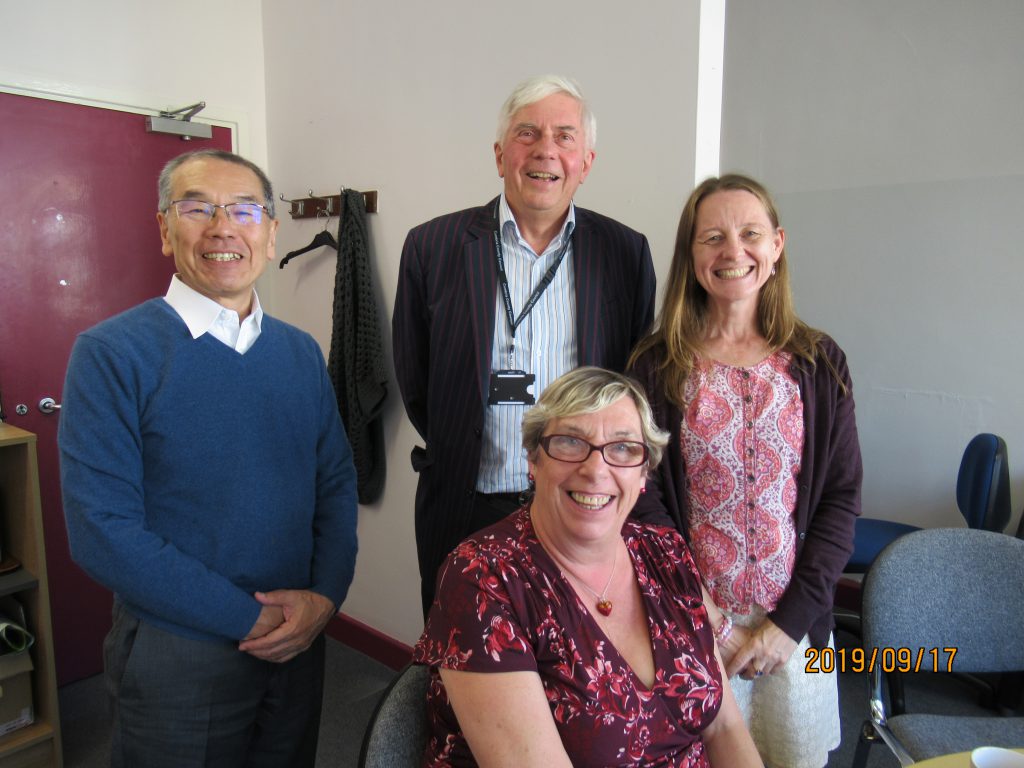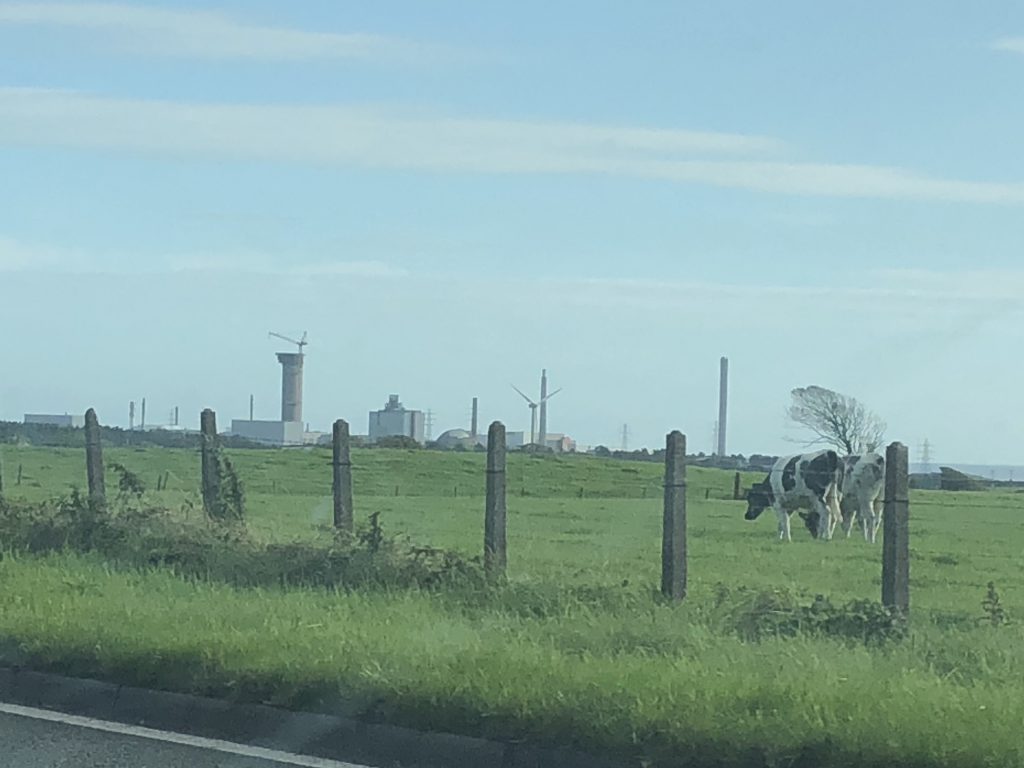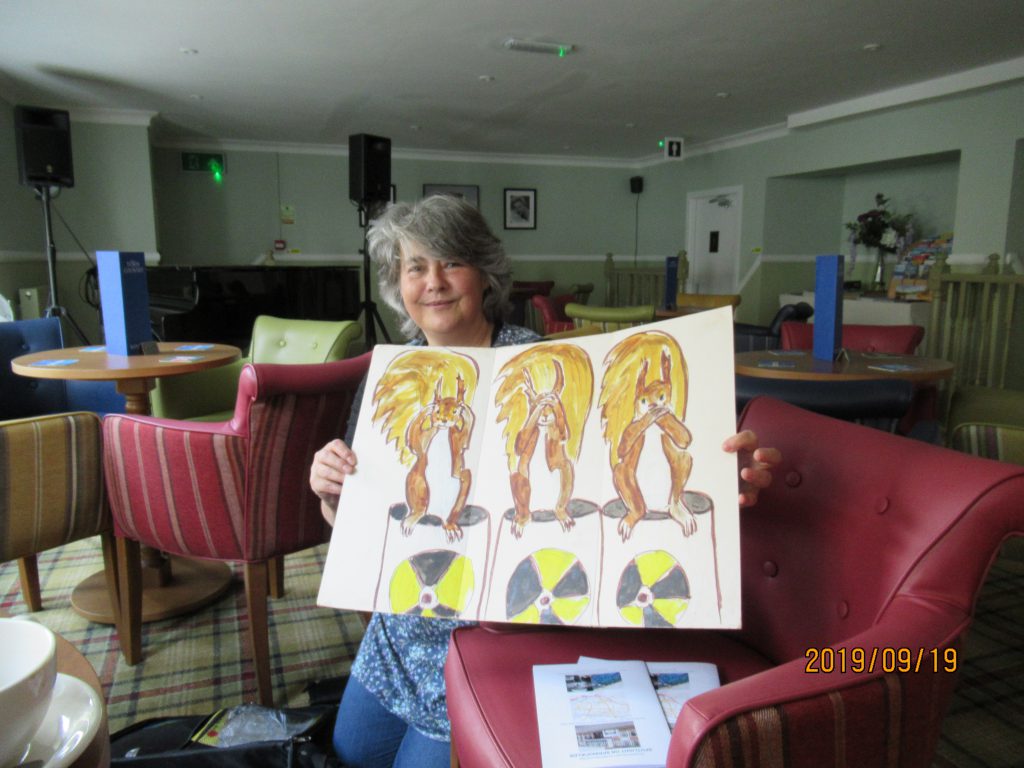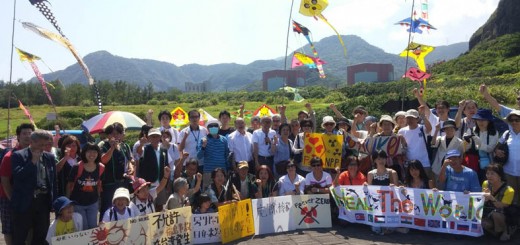What should be done with Japan’s plutonium now stored in the UK? ~ Research trip report
by Caitlin Stronell, CNIC
From September 11 to 21, Ban Hideyuki and Caitlin Stronell from CNIC visited the UK in order to survey opinions on what should be done with Japan’s 21.2 tons of plutonium presently stored at the Sellafield facility in the UK. As Japan does not have an operating reprocessing plant, spent fuel was shipped to the UK and France for reprocessing and fabrication into MOX fuel from the late 1970s. Including Japan’s 21 tons, a total of approximately 140 tons of separated plutonium are held in the UK, which has offered to take ownership of foreign owned plutonium on its soil, subject to acceptable commercial terms. There have already been several such cases of ownership transfers of plutonium. (For example, in January 2017 the UK took ownership of 600 kg of plutonium previously owned by a Spanish utility and 5 kg previously owned by a German organization.)
Last year Japan’s Ministry for Economy, Trade and Industry (METI) announced that a dialogue concerning plutonium between the UK and Japan had begun. Although the details of this dialogue have not been released, ownership transfer may well be one of the discussion points. If Japan does go through with the ownership transfer, it will be an admission that the plutonium, which it has spent vast sums on extracting from the spent fuel, is not a precious resource at all, but material that now has to be disposed of, again at large cost. This would be another heavy blow against Japan’s reprocessing policy. However, how do people in the UK feel about accepting 21 tons of Japanese plutonium? This was what we tried to find out on our research trip.
Closely related to the issue of plutonium in both Japan and the UK is the issue of nuclear waste and we also wanted to find out about how the UK is planning to deal with this issue, especially in terms of siting a Geological Disposal Facility (GDF). Plans to site the GDF in Cumbria were rejected by the Council in 2013 and since then the national government has introduced a new system where smaller communities are able to request that they be considered as a GDF site. We wanted to find out how people were reacting to this and what the prospects are for the government being able to successfully site a GDF under this system.
We spoke to a large range of people directly concerned with these issues, of course anti-nuclear activists, but also a scientist involved in research on direct disposal methods for plutonium, as well as a number of people who work at Sellafield and local councilors for the area. Their answers to the question of what to do with Japan’s 21 tons of plutonium were varied and, in some cases, a little unexpected. For example, I was expecting that Prof. Neil Hyatt of Sheffield University, who is conducting cutting edge research on plutonium disposal, would be more open to accepting Japan’s plutonium, but he expressed some hesitation, saying that if the UK government agrees to take ownership of such a large amount of plutonium, it will break trust with local people by increasing their waste burden.
Divided opinions

We also noticed a split opinion between the two Cumbrian Councillors we interviewed. Cumbria is the county where the Sellafield Site is located and the nuclear industry obviously plays an important part in the local economy and politics, so it is not surprising that there are many differing views within the County Council. We interviewed Cr. David Southward, who holds the economics portfolio in the Council and Cr. Celia Tibble, who holds the environment portfolio. Cr. Southward told us that he had worked as a civil engineer in Sellafield for 25 years and he had complete faith in the safety of operations at the site. He thought that the local community would welcome ownership transfer of Japanese plutonium as it would bring in income and people would also see it as providing jobs. Cr. Southward saw plutonium very much as a resource and thought that disposing of it in a repository would be ‘criminal.’ Cr. Tibble, on the other hand, thought that there would likely be loud protests if the UK accepted the Japanese plutonium. “Imagine the newspaper headlines,” she said “‘Government accepts foreign plutonium on top of the pile we already have’ ‘Cumbria becoming a nuclear dump.'” Her view was that Sellafield certainly provides jobs to people living nearby, and it provides knock-on jobs too for related businesses, but there is a large population living on the ‘M6 Corridor’ (in the vicinity of the main motorway – M6) who are often better-off, retired people who can afford to say no to the nuclear industry. It seems the economic divide in Cumbria is quite severe and the nuclear industry has by no means brought prosperity to all.
The view from the Sellafield side

We met with John McNamara, the Nuclear Decommissioning Authority (NDA) ‘s Director of Stakeholder Relations at the Beacon Museum in Whitehaven, which is very close to the Sellafield Site. Although John’s area of responsibility does not include plutonium ownership transfer, so he couldn’t speak to us about that, he did give us a detailed description of how NDA engages with nuclear communities as well as the Geological Disposal Facility (GDF) siting process. He told us that the NDA had two roles, firstly to safely and efficiently clean up all UK’s nuclear sites and secondly to assist with creating a sustainable post-nuclear future for affected communities. He said that the government wanted to avoid the impacts that the closure of the coal industry had on communities in the 1980s by helping communities that are economically reliant on the nuclear industry to achieve a soft landing when their nuclear power plants close down.
He elaborated on the Site Stakeholder Groups (SSG) which are set up in all communities that host nuclear facilities. Meetings are held about four times a year and include about 24 members who are elected representatives in the community (local council members, etc.). The owners of the nuclear site as well as regulators attend these meetings and answer questions from the stakeholders. Some of the meetings are open to the general public and the press, who are able to ask questions and get replies from officials or other stakeholders (many of the activists we spoke with also agreed that the stakeholder meetings had become much more accessible over the years. At the beginning the general public were not even allowed to ask questions). There are many different views within communities regarding how they would like their community to develop after the nuclear power plant is decommissioned and the stakeholder meeting is to discuss all the views and come up with a coherent plan for their future. NDA also allocates funding so that this plan can be implemented. John gave us a concrete example of the Whitehaven SSG, which decided that their community wanted to upgrade the standard of education available to their young people, so, along with other partners, NDA helped fund two new school campuses, one for special needs children, at a cost of 30 million pounds.
The NDA is also tasked with siting the GDF for radioactive waste, which has proved to be a difficult task indeed, as it is all over the world, including in Japan where little progress has been made. There have been three attempts so far in the UK to try to decide on a site for the GDF, none of which have yielded results and so a new process for finding a GDF site began in January 2019. This process allows any community, no matter how small, to express an interest in starting a dialogue regarding hosting a GDF.
John emphasized that any community in England or Wales could apply and that communities in, for example, Kent, Surrey or East Anglia would be treated equally and “could have the same conversation as communities in West Cumbria.” He mentioned that smaller communities do reach a stage in the process where the County Council has to become involved, but it seems that NDA wants to build a momentum amongst enthusiastic smaller communities and perhaps use this to pressure the wider community, where opposition is likely to be stronger. In 2013 the Cumbria County Council withdrew from the previous GDF siting process although two smaller district councils were in favor of proceeding. It remains to be seen whether this NDA strategy will work but major problems remain, including transportation of massive amounts of radioactive waste across the country if a distant site is selected. Convincing the larger affected community, which would not be getting the financial and other benefits of the hosting community, will certainly be very difficult.
At the Beacon Museum we also met with Phil Hallington, Head of Policy at Sellafield, who spoke to us at length on the history of Sellafield. Phil had worked there for 43 years, and his father had also worked in the nuclear industry right from its beginning. He was very proud of the achievements made at Sellafield and the contribution to the country made across the generations.
Phil commented that more than 4000 samples every year are taken from the area surrounding Sellafield to monitor radiation levels, and most of the radiation that is detected comes from historic releases. He said that when Sellafield began to operate on a commercial basis, things had to be done according to stricter safety rules and actually this helped clean up the environment. But he acknowledged sadly that the commercial base has now dried up and without customers it is impossible to continue as before. Although he didn’t comment directly on whether UK should accept the stockpiled Japanese plutonium, accepting the Japanese plutonium would also, presumably, be a matter of agreeing on the right commercial terms.
It was very interesting to see that even someone who was born and raised in a ‘nuclear family’ and who was a member of what we would call the ‘nuclear village’ in Japan, with a mindset that is very much pro-nuclear, would still acknowledge the reality that the nuclear fuel cycle is no longer commercially viable. I wondered why this type of acknowledgement by people in similar positions in Japan is almost impossible and how we could change this mindset.
Myriad problems according to activists
Regarding the plutonium ownership transfer, even among activists, views were divided. Some said that transporting the separated plutonium back to Japan was not safe or realistic and, in any case, the UK already had 140 tons to deal with, so another 20 would not make all that much difference. Other activists said that any more plutonium at all was not welcome.

One of the activists we met with was Marianne Birkby of Radiation Free Lakeland (RFL), who informed us about some of the many problems that are impacting the local community. For example, Sellafield has recently outsourced its laundry to a company in nearby Workington, but the effluent water discarded after washing mats, etc. from Sellafield that presumably contain radioactive particles, is ‘running down the streets of Workington.’ Drawing attention to the radioactive environment in which people are forced to live and demanding changes is the focus of RFL campaigns. RFL tested radiation levels at local beaches and found that one third of the random samples tested were over the regulation safety limits. They have demanded that local authorities at least inform the public using the beaches of the health risks they face, but to no avail. Indeed, the Environment Agency and Sellafield stop monitoring radioactive particles on the beaches altogether in the summer months because, according to Marianne, they don’t want to alarm the public.
These and many other campaigns led by local communities show that the authorities and industry claims of transparency and safety cannot be trusted and in this sense it was easy to understand comments by Cr. Celia Tibble regarding the public reaction if the UK government were to accept Japanese plutonium. It would be seen as another lie and breach of trust.
Local authorities and global campaigns
Another activist we met with was Sean Morris, who is Secretary of the Nuclear Free Local Authorities (NFLA). On the question of the ownership transfer of the Japanese plutonium, his view was that, due to Brexit, the UK was desperate to make international friends and that Japanese leverage would be very strong, so if Japan wanted to, transferring the plutonium could well be easier than they thought.
Sean had just got back from an NFLA meeting in Scotland, which was a very positive experience. He explained that calls for Scottish independence are reflected in their energy policies, which are very different from England’s. Scotland now gets 120% of its energy from renewables and has a no new-build nukes policy. It’s nuclear waste policy is also different from England in that it does not plan to bury it, but rather store the waste on the surface where it can be monitored for safety.
NFLA has connections with various international organizations including Mayors for Peace in Japan, and Sean and some of his colleagues plan to be in Japan next year for the 75th anniversary of the Hiroshima/Nagasaki atomic bomb attacks. He suggested that first with the Rugby World Cup in Japan and next year with the Tokyo Olympics, much international media attention will be focused on Japan and that we should all join together in campaigns to draw attention to the ongoing problems in Fukushima to demand an end to nuclear power. Nuclear waste is also a major problem and reprocessing is not the solution; it only serves to raise proliferation fears in an already sensitive region. Next year will present many opportunities to get these messages out to the global community.
Conclusion
I thought that there were many similarities between the situation in Japan and in the UK regarding nuclear fuel cycle policy. Both countries must deal with massive amounts of plutonium, extracted at huge cost and risk, which now has no apparent use. Both the governments of Japan and the UK try to convince themselves and the world that it can be used as MOX fuel, but without a fabrication plant or sufficient MOX reactors, this solution is totally unconvincing. In the UK, it seems at least some industry people are facing up to this reality. In Japan, however, the government, at least at a policy level, hasn’t even faced up to the reality that plutonium is not a resource. Transferring ownership of its 21 tons of plutonium held in Sellafield to the UK would be an important step in facing up to this reality and could open the door to more practical and constructive discussions on how to reduce the plutonium stockpile. These discussions will not be easy and require an honest and concerted effort on the part of local and national governments, industry, communities and citizens.
Obituary

On Sunday 15 September we met with Martin Forwood and his partner Janine Allis-Smith at their house in a remote part of south-west Cumbria. Martin and Janine were founders of Cumbrians Opposed to a Radioactive Environment (CORE) which has been fighting Sellafield since the 1980s, firstly regarding the plutonium discharges, which many believe were responsible for an increase in leukemia, including Janine’s son, who was diagnosed in 1980. Martin became convinced that reprocessing was only producing plutonium that had no use and fought a long battle for the closure of Sellafield. He was known amongst activists as one of the ‘Pluto Boys’ for his extensive knowledge of plutonium and was respected even by people in the nuclear industry. We were very shocked to hear that Martin passed away only a couple of weeks after we met with him. This is a devastating loss to many people and the movement. Meeting Martin was very inspiring and made me feel strongly that we must carry on his important work.

